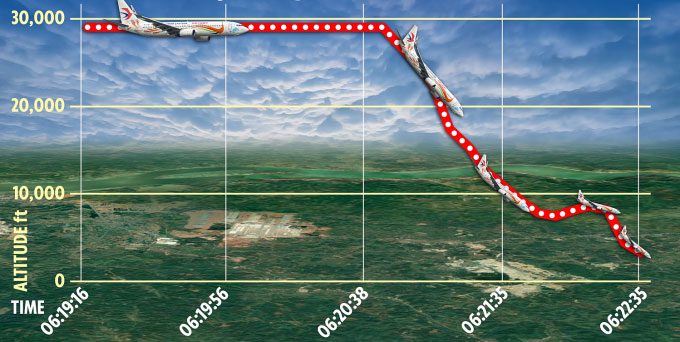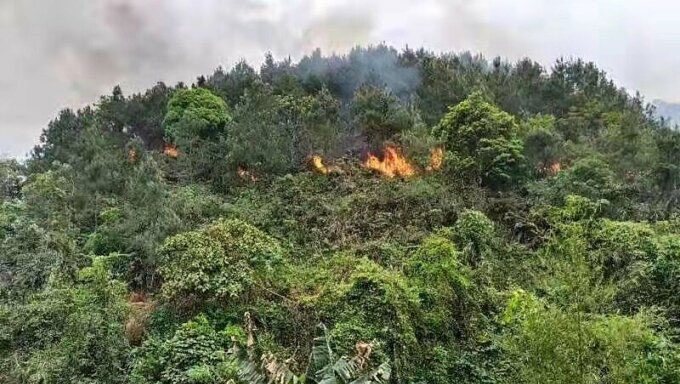The China Eastern Airlines flight carrying 132 people plummeted almost vertically at speeds of hundreds of kilometers per hour, which could have incapacitated the pilots, according to experts.
Video footage appearing to capture the final moments of flight MU5735 from China Eastern Airlines was widely shared on Chinese social media a few hours after the aircraft crashed into a mountainside in Guangxi province on March 21. The footage shows that the plane descended almost straight down.
British aviation expert Sally Gethin believes that the cause of the MU5735 crash is very different from previous incidents involving Boeing 737 MAX aircraft from Lion Air and Ethiopian Airlines. In those two flights, the Maneuvering Characteristics Augmentation System (MCAS) malfunctioned, causing the aircraft to pitch up excessively, leading to a stall and subsequent crash.
Gethin stated that it is still too early to predict the cause of the MU5735 accident, but she speculates that the aircraft’s tail may have encountered issues. According to her, when the plane descended almost vertically for nearly two minutes, the G-forces would have caused blood to rush to the pilots’ brains and those on board.
This force could lead to the pilots losing consciousness and losing control of the aircraft. However, flight data indicates that during the descent, the plane regained a level attitude for about 10-20 seconds, suggesting that one or both pilots regained consciousness and attempted to save the aircraft, but to no avail.
Data collected by Flightradar24 shows that the aircraft was flying at an altitude of nearly 9,000 meters around 2:20 PM on March 21, more than an hour after takeoff, when it suddenly began to descend. After briefly climbing back to just over 2,000 meters, the aircraft continued its rapid descent at nearly 600 km/h in the final seconds.

Flight data shows MU5735’s sudden altitude drop and nearly vertical descent. (Photo: Sun).
Rescue teams were immediately deployed to the scene, but none of the 132 people on board, including 123 passengers and 9 crew members, were believed to have survived, making it the deadliest aviation disaster in China in decades.
Experts suggest that when examining the crash site, investigators will particularly focus on the elevator, the component that controls and adjusts the nose altitude of the aircraft. Juan Browne, a Boeing 777 pilot and popular vlogger who analyzes aviation incidents, stated.
“There is really only one thing that could cause an aircraft to descend vertically, and that is the elevator.” Browne noted that if the issue were not with these components, the aircraft would have to be continuously climbing and descending.
According to Browne, “it’s extremely rare” for an aircraft to crash in such a nearly vertical state.
Jean-Paul Troadec, former director of the French Bureau of Investigation and Analysis for Civil Aviation Safety, stated that MU5735’s flight data is “very unusual”, but emphasized that it is “too early” to draw conclusions.

A hillside ablaze at the crash site of the China Eastern Airlines flight on March 21. (Photo: Xinhua).
It is currently unclear whether investigators have recovered the aircraft’s black box. This device could provide them with information regarding the aircraft’s operations, pilot actions, and cockpit sounds. They may also analyze video footage from security cameras operated by a local mining company or dashcam videos from vehicles traveling near the crash site to review the accident from another perspective.
The U.S. Federal Aviation Administration stated that it is “ready to assist investigation efforts if requested”, while Boeing announced that it is cooperating and ready to support China Eastern Airlines.
Flight MU5735 departed from Kunming Changshui International Airport in Kunming, Yunnan Province, at 1:15 PM on March 21, and was scheduled to land in Guangzhou, Guangdong Province. However, the aircraft crashed more than an hour after takeoff. China Eastern has grounded all its 737-800 aircraft following the accident but has not released information regarding casualties.




















































